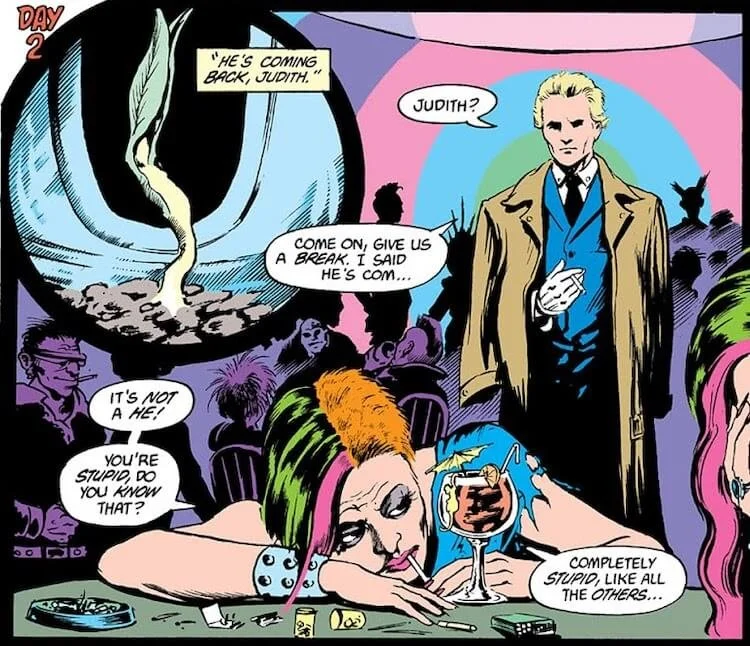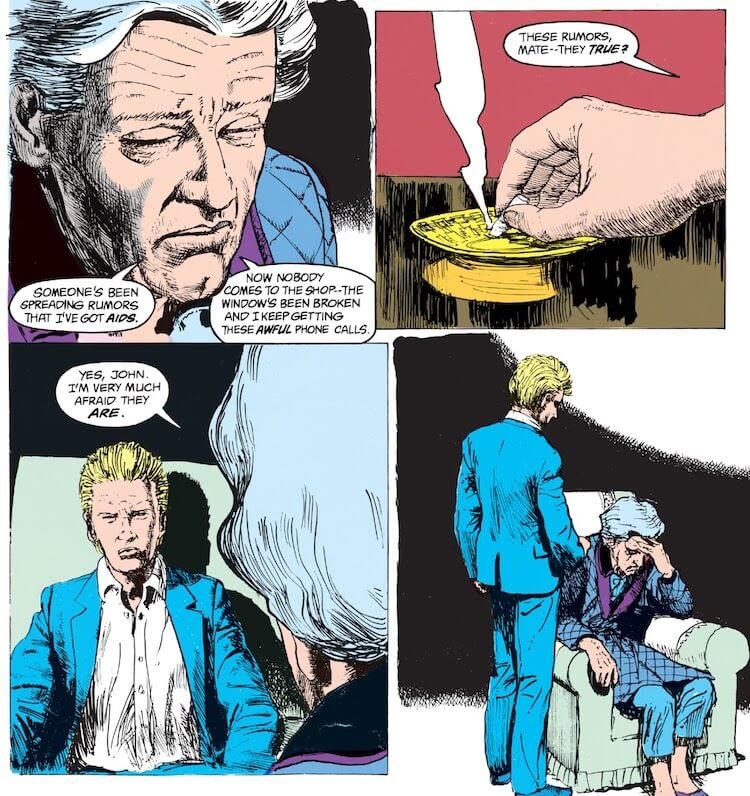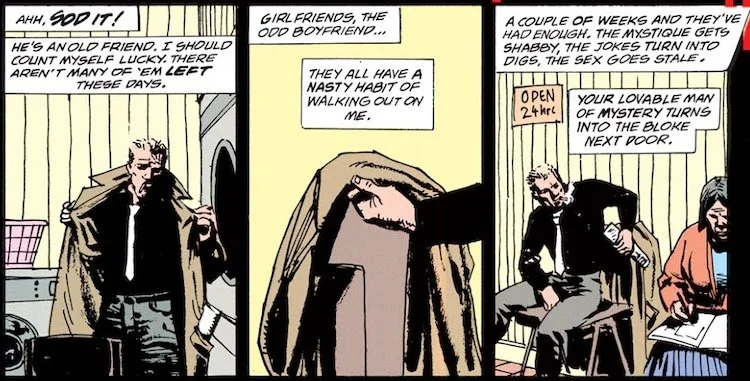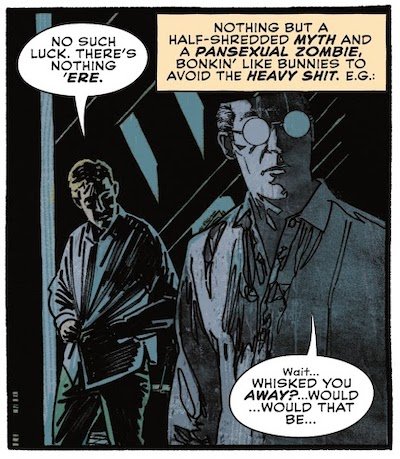Queer Superhero History: John Constantine
It’s time for another installment of Queer Superhero History, where we look back at queer characters in mainstream superhero comics, in (roughly) chronological order, to see how the landscape of LGBTQ+ rep in the genre has changed over time. Today: John Constantine!
I debated over including Constantine in this series. For one thing, the focus is meant to be mainstream superhero comics, and John has never fit comfortably in the regular DCU; he’s certainly no superhero. For another, I am very much not an expert on the character, and reading 300 issues of Hellblazer for a single article is a more daunting proposition than tackling a dozen or so Arnie Roth appearances.
All that said, John is one of the most prominent queer characters in mainstream comics, with his own movie and TV show. So let’s give a shot, with the caveat that we’re by necessity really only scratching the surface here.
Our (almost) first sight of John Constantine. [The Saga of the Swamp Thing #37 (June 1985), art by Rick Veitch and John Totleben.]
John Constantine is a working class magician and occult detective from London. He initially appeared in The Saga of the Swamp Thing #37 (June 1985), and was created by Alan Moore, Steve Bissette, and John Totleben. He was popular enough that in 1988 he got his own series, Hellblazer, which would eventually become the longest-running series of DC’s Vertigo imprint at 300 issues. And just to get all the usual bits of trivia out of the way right at the top: yes, he was originally drawn to look like Sting; yes, Alan Moore and a number of other writers who have worked on the character claim to have met him in real life, although I kind of get the impression all the writers after Moore are just playing along; and yes, the last syllable of his last name is meant to rhyme with “shine,” not “sheen,” although I’m sorry to say that Moore has quite thoroughly lost that particular battle. (I’m not actually sorry.)
Constantine debuted during the rise of comics written for an adult audience rather than kids and teens (as well as the rise of all those awful “Biff! Bam! Pow! Comics Aren’t Just For Kids Anymore!” headlines). This was supported by the growth of the direct market, A.K.A. comic book stores; while comics sold through newsstands still had to go through the Comics Code Authority, direct market comics did not. When the CCA refused to approve The Saga of the Swamp Thing #29 in 1984, DC stopped submitting the book for approval. With Hellblazer, they never bothered.
These “mature” direct market comics were always somewhat separate from the regular DCU, and this gulf widened in 1993, when DC moved them into a new imprint called Vertigo. The history of Vertigo is longer than we have space for here, but suffice to say that as a mature readers’ imprint, its books tended to include more sex, graphic violence, profanity, and other CCA-violating content than a regular DC book, as well as being generally considered more prestigious.
Even before moving to Vertigo, Hellblazer was all about pushing boundaries, and so, like fellow Vertigo transplant Sandman, it always included queer content. This is…a mixed bag. As I’ve mentioned before, when comics in the late 80s touched on queerness they tended to emphasize gaybashing, sexual violence, and AIDS; combine that with Hellblazer’s deliberate edginess and the fact that John’s life is a grimy slog through never-ending horror, and the queer content in early Hellblazer is pretty relentlessly bleak and often tawdry. The very first issue (written, like almost all of the first 40 issues of the series, by Jamie Delano) mentions sexual exploitation of young boys. Issue #3 introduces John’s friend Ray Monde, an older gay man; in #6 he tells John that he has AIDS; in #7 he’s beaten to death by homophobes. (In the comic’s defense, I will argue that this is not an example of Bury Your Gays; anyone who spends enough time with John, regardless of race, gender, or sexuality, is almost certain to die horribly, including plenty of straight white guys. It’s Bury Your Everyone John Has Ever Met.)
John learns that his friend Ray has AIDS. [Hellblazer #6 (June 1988), art by John Ridgway.]
Now on the one hand, all the terrible things that happen to gay characters in Hellblazer are, in fact, meant to be understood as terrible things. John is consistently horrified by them, and intervenes when he can. And it’s worth remembering again that this series began in 1988 and the Code wouldn’t officially permit queer characters until 1989; even though Hellblazer wasn’t submitted for CCA approval, most comics were. To depict queer tragedies explicitly and sympathetically was in fact progressive for a mainstream comic at the time.
On the other hand, at its best the treatment of gay characters can feel voyeuristic and exploitative. At its worst, it crosses over into shock value and actively linking queerness with evil and predation, as with issues #68-69 (written by Warren Ellis), in which John befriends a gay sex worker who has just escaped a violent customer who wanted him to have sex with a dog; the sex worker is then killed by a bisexual vampire. Oh, and he had AIDS. Because of course he did.
Part of what makes the portrayal of queerness in Hellblazer questionable is the Otherness of it all: John has queer friends, but John himself isn’t queer. Or is he? Before Ray Monde’s death, John’s current girlfriend asks Ray if he and John have ever slept together, a question she and Ray both consider as plausible. Later, John is attacked by a demon while he sleeps, who penetrates John’s mouth with his tongue in some extremely suggestive imagery. The demon gives John some of his own blood, causing Ray’s ghost to later tell John that he now has a form of “psychic AIDS,” which is a real yikes of a line, obviously, but further thematically aligns John with queerness. John has never been a paragon of normative heterosexual machismo.
Which brings us to Hellblazer #51 (written by John Smith), in which a maudlin John muses on his loneliness. “Girlfriends, the odd boyfriend…they all have a nasty habit of walking out on me.” Lest we read that line ambiguously, he goes on to say “the jokes turn into digs, the sex goes stale” and “I’m hopeless when it comes to finishing relationships.” As of March 1992, John Constantine officially dated men.
The panels that made John Constantine officially queer. [Hellblazer #51 (March 1992), art by Sean Phillips.]
This would not come up again for another decade. In fact, I suspect that many readers simply missed it.
John’s canonical queerness wouldn’t be addressed explicitly in the text again until the 2002 storyline “Ashes & Dust in the City of Angels” by Brian Azzarello and Marcelo Frusin, which ran in issues #170-174. The story begins with John seemingly burning to death in a BDSM club. His supposed killer is quickly revealed to be a billionaire named Stanley “S.W.” Manor, an ex-lover of John’s and also, weirdly, an obvious pastiche of Bruce Wayne.
If you thought late 80s comics went in for shock value, they had nothing on the 2000s, and that’s not a compliment. At least the 80s stuff was innovative. This story seems mostly to exist to draw as many bare-breasted women in leather boots and silhouetted taboo sex acts as possible. It takes ages to get to its point, which is that John is, of course, not actually dead (although basically everyone else ends up that way). It does, however, show John kissing S.W., and whipping him in the sex club—the first on-page depiction of John with another man. Googling the storyline will find you any number of Reddit threads and Goodreads reviews saying that this highly controversial storyline “made John gay,” which again suggests to me that a throwaway line in 1992 was easily swept under the rug.
Even the most careless reader couldn’t miss this. [Hellblazer #172 (May 2002), art by Marcelo Frusin.]
Though Hellblazer had an illustrious run at Vertigo with its aforementioned 300 issues, John and his old buddy Swamp Thing were folded back into the mainstream DCU with their 2011 New 52 reboot to some reader consternation. DC took pains to assure readers that Vertigo Constantine and DCU Constantine were actually two totally different characters—a point that became moot when Hellblazer was canceled in 2013 and Vertigo as a whole was discontinued in 2020. DC resurrected the imprint last year, but John—now fully in the DCU—has never quite regained his publishing footing. He’s often a jarring note when he appears now, like his extremely uneven teamup with Jon Kent, Superman’s squeaky clean son, in 2023’s Pride special.
John describes himself as pansexual. [Hellblazer: Dead in America #7 (September 2024), art by Aaron Campbell]
All that said, John’s relationships with men have been mentioned more frequently with his return to the mainstream DC universe, although that’s probably less a function of imprint and simply a more tolerant comic book industry. He’s been shown with a number of male ex-lovers and hookups, including a number of demons, naturally. He even had a sweet, ongoing romance with an ordinary man named Oliver in his 2015 solo series, Constantine: The Hellblazer, which of course ended wretchedly for everyone involved because John Constantine is still John Constantine. All of these relationships with men have been interspersed with equally disastrous relationships with women. In Hellblazer: Dead in America #7, John casually referred to himself as pansexual, which may have been the first time he’s labeled his sexuality, but don’t quote me on that. I told you I’m a Constantine dilettante!
John’s sexuality in multimedia has followed a similar timeline. The 2005 movie Constantine starring Keanu Reeves did not so much as hint at John’s queerness. Neither did the 2014 TV show, also named Constantine and starring Matt Ryan. This is significantly less forgivable considering how well established said queerness was in the comics by then. Executive producer Daniel Cerone dismissed the importance of John’s sexuality by saying that in three decades of comics, “there might have been one or two issues where he's seen getting out of bed with a man. So [maybe] 20 years from now?”
Unsurprisingly, Constantine only got one season and not twenty. Luckily for us all, in 2018 Matt Ryan’s version of the character was picked up by the endlessly delightful Legends of Tomorrow, a joyfully queer show that wasted no time in firmly establishing John’s queer bonafides over the three seasons he was a series regular. Ryan also voiced John in 2020’s animated movie Justice League Dark: Apokolips War, which went mildly viral for the scene where it’s revealed that John once dated King Shark. Who is a shark.
As an example of queer representation, John Constantine is often uncomfortable and deeply flawed—which is, of course, extremely in character for him. I would say only Constantine could be both in and out of the closet from arguably 1992 to 2018, but as this series has shown, it’s very easy for straight gatekeepers to willfully ignore what they don’t like. Luckily for us, John has never been particularly concerned with being liked. And at this point, there’s no shoving him and his filthy trenchcoat back in that closet.
So let’s all raise a pint to the Hellblazer—and whatever you do, for the love of god don’t ever date him.




